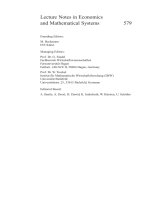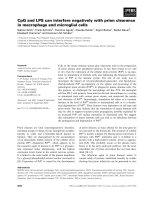Fourier Transforms in Radar and Signal Processing_5 pdf
Bạn đang xem bản rút gọn của tài liệu. Xem và tải ngay bản đầy đủ của tài liệu tại đây (528.45 KB, 22 trang )
97
Interpolation for Delayed Waveform Time Series
Figure 5.7 Flat waveform oversampled.
flat part of the waveform, with constant value unity, has been sampled at
an oversampling rate of q = 3. We see that at the sample points the weight
value is 5/3, but the contributions from the interpolating sinc functions
from nearby sample points are negative, bringing the value down to the
correct level.
The weights given by (5.12) for oversampling factors of 2 and 3 are
shown in Figure 5.8 for comparison with the values for the minimum
sampling rate (q = 1) plotted in Figure 5.4. The same set of delays has been
taken. These plots show that the weight for the tap nearest the interpolation
point (taken to be the center tap here) can be greater than unity, that the
weight magnitudes do not necessarily fall monotonically as we move away
from this point, and that much the same number of taps is required above
a given weight level, such as −30 dB. At first, this last point might seem
unexpected—there is no significant benefit from using the wider spectral
gate that is possible with oversampling. However, the relatively slow falling
off of the tap weight values is a result of the relatively slowly decaying
interpolating sinc function, and this in turn is the result of using the rectangu-
lar gate with its sharp, discontinuous edges. This is the case whether we
have oversampling or not. The solution, if fewer taps are to be required, is
to use a smoother spectral gating function, and this is the subject of the
next section.
5.2.3 Three Spectral Gates
Trapezoidal
The first example of a spectral gate without the sharp step discontinuity of
the rect function is given by a trapezoidal function (Figure 5.9). As illustrated
98 Fourier Transforms in Radar and Signal Processing
Figure 5.8 FIR interpolation weights with oversampling.
Figure 5.9 Trapezoidal spectral gate.
99
Interpolation for Delayed Waveform Time Series
in this figure and also in Section 3.1, this symmetrical trapezoidal shape is
given by the convolution of two rectangular functions with a suitable scaling
factor. The convolution has a peak (plateau) level of (q − 1)F (the area of
the smaller rect function), so we define G by
G( f ) =
1
(q − 1)F
rect
ͩ
f
qF
ͪ
⊗ rect
ͩ
f
(q − 1)F
ͪ
(5.13)
Thus, on taking the transform, g (t) = qF sinc qFt sinc (q − 1)Ft, and
the interpolating function from (5.9) with T ′=1/F ′=1/qF,is
(t) = sinc qFt sinc( q − 1)Ft (5.14)
From (5.8) we have
u(t) = sinc qFt sinc (q − 1)Ft ⊗ comb
1/F
′
u(t) (5.15)
The interpolating function
is now a product of sinc functions, and this
has much lower side lobes than the simple sinc function. To interpolate at
time
=
T ′, where 0 <
< 1 (i.e.,
is a fraction of a tap interval), we
consider the contribution from time sample r, giving
w
r
(
) =
[(r −
)T ′] = sinc (r −
) sinc [(r −
)(q − 1)/q]
(5.16)
Now let x = r −
and y = (q − 1)x/q; then
w
r
(
) = sinc x sinc y = sin X sin Y /XY (5.17)
where X =
x and Y =
y. If we take the case of
=
1
⁄
2
, the worst case,
as in Section 5.2.1, we have sin X = sin
(r −
1
⁄
2
) = (−1)
r
+
1
, and if we take
q = 2 (sampling at twice the minimum rate), then sin Y = sin
(r −
1
⁄
2
)/2
=±1/
√
2 for r integral. So the magnitudes of the tap weights are
|
w
r
ͩ
1
2
ͪ
|
=
|
ͩ
r −
1
2
ͪ
|
=
√
2
2
ͩ
r −
1
2
ͪ
2
(5.18)
100 Fourier Transforms in Radar and Signal Processing
Comparing this with (5.5), we see that the weight values now fall very much
faster, and this is illustrated in Figure 5.10 for comparison with Figures 5.4
and 5.8.
We see that the number of taps above any given level has been reduced
dramatically—above −30 dB, for example, from 20, 15, and 7 at q = 1 for
the three delays chosen, to 4, 3, and 3 at q = 2; and as few as 2, 3, and 2
at q = 3. Above the −40-dB level, the number of taps needed at 0.5T
is found to be 65 at the minimum sampling rate, but only 8 for q = 2 and
q = 3.
Rectangular with Trapezoidal Rounding
The trapezoidal function still has slope discontinuities, though not the step
discontinuities that the rect function has. The corners of the trapezoid can
be rounded by another rect convolution, to make three convolved rect
functions in total. The combination of the two narrower rect functions, the
first removing the steps and the second removing the abrupt slope changes,
together form a trapezoidal rounding pulse as illustrated in Figure 5.11. As
before, the main rect function is of width qF (as in Figure 5.9) and the
overall rounding pulse is of base length (q − 1) F, as this is the space available
for the rounding, on each side. Let the two shorter rectangular pulses be of
length
␣
(q − 1)F and (1 −
␣
)(q − 1)F, where 0 <
␣
≤ 0.5, and then their
convolution will be of the required length (q − 1)F as shown in the upper
part of Figure 5.11. If these pulses are of unit height, then the trapezoidal
pulse will be of height
␣
(q − 1)F, the area of the smaller pulse, so we
need to divide by this factor to form a trapezoidal pulse of unit height. The
area of the trapezoidal pulse A is the same as that of the wider rectangle,
(1 −
␣
)(q − 1)F, and we also have to divide by this factor when we perform
the second convolution in order to make the height of G unity, as required.
Thus we have
G( f ) =
rect f /qF ⊗ rect f /
␣
(q − 1)F ⊗ rect f /(1 −
␣
)(q − 1)F
␣
(1 −
␣
)(q − 1)
2
F
2
(5.19)
The interpolating function
is given by
(t) = (1/qF )g( f ) = sinc qFt sinc
␣
(q − 1)Ft sinc (1 −
␣
)(q − 1)Ft
(5.20)
Let t = (r −
)T ′ as before (with 0 <
≤ 0.5), x = qFt = r −
, and
y = (q − 1)x/q ; then
101
Interpolation for Delayed Waveform Time Series
Figure 5.10 Filter weights with oversampling and trapezoidal spectral gate.
102 Fourier Transforms in Radar and Signal Processing
Figure 5.11 Trapezoidal rounding.
w
r
(
) =
[(r −
)T ′] = sinc x sinc (1 −
␣
)y sinc
␣
y (5.21)
=
sin X sin Y
1
sin Y
2
XY
1
Y
2
where X =
x, Y
1
=
␣
y and Y
2
= (1 −
␣
)
y.
If
␣
= 0.5, we have a triangular pulse for the rounding convolution,
but this may make the edge too sharp. As we reduce
␣
, we go through the
trapezoidal form towards the rectangular case considered above. The weights
for the same three delays as before are plotted in Figure 5.12 for oversampling
factors of 2 and 3, for a value of
␣
of 1/3. Again we see that very few taps
are needed compared with the rectangular case, and the weight values are
seen to be falling away more rapidly than for the simple trapezoidal case,
as expected.
Rectangular with Raised Cosine Rounding
Here we use a raised cosine pulse for rounding instead of the trapezoidal
pulse above. This pulse is of the form 1 + cos (af ), so it has a minimum
value of zero and is gated to one cycle width, this being the required value
(q − 1)F.If2A is its peak value, then the pulse shape (in the frequency
domain) is given by A rect [ f /(q − 1) F ]{1 + cos [2
f /(q − 1)F ]} (Figure
5.13). This has integral A ( q − 1)F, due to the raised offset only, as the
integral of the single cycle of the cosine function within the rect gate is zero.
In order to make the area unity, we take A = 1/(q − 1) F. Applying this to
the main spectral gating rect function to give the smoothed form, we have
G( f ) = rect
f
qF
⊗
ͭ
rect
ͫ
f
(q − 1)F
ͬ
(1 + cos [2
f /(q − 1) F ]
(q − 1) F
ͮ
(5.22)
103
Interpolation for Delayed Waveform Time Series
Figure 5.12 Filter weights with oversampling and trapezoidal rounded gate.
104 Fourier Transforms in Radar and Signal Processing
Figure 5.13 Raised cosine rounding.
and
g(t) = qF sinc qFt
ͭ
sinc (q − 1)Ft ⊗
ͫ
␦
(t) +
␦
(t − ⌬t) +
␦
(t + ⌬t)
2
ͬͮ
where ⌬t = 1/(q − 1) F. On performing the
␦
-function convolutions, the
interpolating function is
(t) =
1
qF
g(t)
= sinc qFt
ͭ
sinc (q − 1)Ft +
1
2
sinc [(q − 1)Ft − 1] +
1
2
sinc [(q − 1)Ft + 1]
ͮ
(5.23)
The term in braces {} has much lower side lobes, though a wider main
lobe, than the basic sinc function, as should be expected from the form of
the gating, or windowing, function G (Hamming weighting). With the same
notation as above, we have for the delay
=
T ′,
w
r
(
) =
[(r −
)T ′] = g[(r −
)T ′]/qF (5.24)
= sinc x
ͫ
sinc y +
1
2
sinc ( y − 1) +
1
2
sinc ( y + 1)
ͬ
Putting
sinc ( y ± 1) =
sin
( y ± 1)
( y ± 1)
=
−sin
y
( y ± 1)
we have
105
Interpolation for Delayed Waveform Time Series
w
r
(
) =
sin
x sin
y
2
x
ͫ
1
y
−
1
2( y − 1)
−
1
2( y + 1)
ͬ
(5.25)
=
−sin
x sin
y
2
xy ( y
2
− 1)
=
sin X sin Y
XY (1 − y
2
)
Compared with the case of the trapezoidal gate above [see (5.17)],
there is an extra factor in the denominator of 1 − y
2
, which is effective in
reducing the magnitudes of w
r
when r is large. Figure 5.14 shows the weights
for the same delays and oversampling factors as before, and we see that the
weight values fall even faster than with trapezoidal rounding as a result of
the very smooth form of this rounding.
5.2.4 Results and Comparisons
In this section we give the tap weights (in decibels) for the case
=
1
⁄
2
, that
is, for the worst-case interpolation, half-way between two taps. For smaller
, the weight values will fall faster with r. For small delays (very much less
than T ′/2), oversampling may hardly be needed to keep down the number
of taps while maintaining good signal fidelity, but in many applications any
delay may be required, and here we evaluate the tap weights for the worst
case.
Results for four different interpolation expressions are obtained below,
following the different spectral gating functions given above. These are
1. Maximum width rectangular gating (5.12)
w
r
(
) = sin [(2q − 1)X/q]/X [X =
(r −
)]
2. Trapezoidal spectral gating (5.17)
w
r
(
) = sin X sin Y /XY [Y = (q − 1)X/q ]
3. Gate with trapezoidal rounding (5.21)
w
r
(
) = sinc x sinc (1 −
␣
)y sinc
␣
y =
sin X sin Y
1
sin Y
2
XY
1
Y
2
[Y
1
=
␣
Y, Y
2
= (1 −
␣
)Y ]
106 Fourier Transforms in Radar and Signal Processing
Figure 5.14 Filter weights with oversampling and raised cosine rounded gate.
107
Interpolation for Delayed Waveform Time Series
4. Gate with raised cosine rounding (5.25)
w
r
(
) =
sin X sin Y
XY (1 − y
2
)
( y = Y/
)
Figure 5.15 shows, in contour plot form, how the filter tap weights
vary with oversampling rate for the worst-case delay of 0.5T. The tap weights
are given in decibel form with tap number along the x-axis and oversampling
rate along the y -axis. The contours are at 10-dB intervals. Only integer
values for the tap numbers are meaningful, of course, but the expressions
above are not restricted to integer values of r, and so contour plots can be
drawn. We see how the weight values fall only slowly at q = 1, but only a
small increase, to 1.2, for example, reduces the levels rapidly. The general
pattern is fairly similar for three of the different gating functions, with the
trapezoidal rounded gate perhaps the best, but the rectangular gate is very
much poorer in rate of fall of coefficient strength with increasing sampling
factor. This is consistent with the discussion of Figure 5.8.
5.3 Least Squared Error Interpolation
5.3.1 Method of Minimum Residual Error Power
In Section 5.2 we saw how to approximate the time series for the sampled
delayed waveform, given the time series of a sampled waveform. The approxi-
mation is not exact, because only a finite set of FIR filter taps can be used
in practice. The error in curtailing the filter is not evaluated, because this
will depend on the actual waveform, and the approach of that section is
independent of the waveform, given that it is of finite bandwidth. In this
section a different approach is taken; the question tackled is, given a finite-
length filter, what is the set of tap weights that minimizes the error (in
power) in the delayed waveform series? To answer this question, we do not
need the actual waveform, but only its power spectrum, and some example
spectral shapes are taken to illustrate the theory in Section 5.3.2 below.
Figure 5.16 shows the FIR filter model, similar to Figure 5.1, with
the waveforms x added. We do not distinguish between the continuous
waveforms and the sampled forms, as we know that, correctly interpolated,
the sampled series form will give the continuous one exactly for a band-
limited signal. If we let the required output waveform be delayed by
T relative to the waveform x(t) at the center tap, then it is given by
108 Fourier Transforms in Radar and Signal Processing
Figure 5.15 Tap weight variation with oversampling rate for four spectral gating functions at delay 0.5T: (a) rectangular, (b) trapezoidal,
(c) trapezoidal rounded, and (d) raised cosine rounded.
109
Interpolation for Delayed Waveform Time Series
Figure 5.16 FIR filter for interpolation.
x(t −
T ). T is the sampling period and
(where 0 <
< 1) is the delay
offset as a fraction of this interval. Although x(t −
T ) is indicated as the
actual filter output in the figure, this could only be achieved with an infinite
set of taps, correctly weighted; the actual output, with the tap weights derived
below, is a least squared error approximation to this. The error waveform,
the difference between the desired output and that given by the FIR filter,
is e(t), given by
e(t) = x (t −
T ) −
∑
n
k
=−
n
x(t − kT )w
k
(5.26)
Taking the Fourier transform of this equation we have
E( f ) = X( f ) exp (−2
if
T ) −
∑
n
k
=−
n
X( f ) exp (−2
ifkT )w
k
= X( f )G( f )
where
G( f ) = exp (−2
if
T ) −
∑
n
k
=−
n
exp (−2
ifkT )w
k
(5.27)
The error power p , considered to be a function of the set of weights, is
given by
110 Fourier Transforms in Radar and Signal Processing
p =
͵
∞
−∞
|
E( f )
|
2
df =
͵
∞
−∞
|
X( f )
|
2
|
G( f )
|
2
df (5.28)
(Here the limits of the second integral could be −F /2 and F/2, as x is taken
to be band-limited, with no spectral power outside this interval.) We suppose
that the waveform is of unit power so that ͐
∞
−∞
|
X( f )
|
2
df = 1. From (5.27)
we have
|
G( f )
|
2
= 1 − 2Re
΄
∑
∞
k
=−∞
exp (−2
if
T )e
2
ifkT
w
k
*
΅
(5.29)
+
∑
∞
h
=−∞
∑
∞
k
=−∞
e
2
if (h
−
k)T
w
k
* w
h
Inserting this into (5.28), we can express the error power in a vector-
matrix form by
p(w) = 1 − 2Re{w
H
a} + w
H
Bw (5.30)
where we define
w = [w
−
n
w
−
n
+
1
w
n
]
T
(5.31)
and the elements of the vector a and the matrix B, of sizes 2n + 1 and
(2n + 1) × (2n + 1), respectively, are given by
a
k
= r [(
− k)T ] and b
hk
= r [(h − k )T ] (5.32)
where
r(
) =
͵
∞
−∞
|
X( f )
|
2
exp (2
if
) df (5.33)
[The raised suffixes T and H indicate matrix transpose and complex conjugate
(Hermitian) transpose, respectively]. We see that the components a
k
and
b
hk
are values of the autocorrelation function of the waveform x,asr is the
111
Interpolation for Delayed Waveform Time Series
Fourier transform of the power spectrum of x, and this gives the autocorrela-
tion function by the Wiener-Khintchine theorem (Section 2.3).
By differentiating p(w) with respect to w* and setting the differential
to zero (see Brandwood [1], for example) we find that p is a minimum when
the weight vector is w
0
given by
w
0
= B
−
1
a (5.34)
and the minimum error power is p
0
, given by
p
0
= 1 − a
H
B
−
1
a (5.35)
To calculate w
0
and p
0
, we only require a and B, the components of
which are all obtained from the autocorrelation function of the waveform.
We do not need to postulate particular waveforms for x in order to calculate
the optimum weight and the minimum residue, which will depend on the
number of taps, the sampling interval, and the delay, but only its spectral
power function. Choosing some simple functions, which approximate likely
spectra of real signals, it is possible to obtain values for the weights and the
residues quite easily. In the next section, we use the rules-and-pairs technique
to find the autocorrelation function for six spectral shapes, and in Section
5.3.3 we show some results.
5.3.2 Power Spectra and Autocorrelation Functions
Rectangular Spectrum
In this case we take the power spectrum
|
X( f )
|
2
to be given by
(1/F ) rect ( f /F ), the factor 1/F being required to normalize the total power
to unity. The Fourier transform of this is r(
) = sinc (F
), so we have, for
the components of a and B,
a
k
= sinc [(
− k)FT ] and b
hk
= sinc [(h − k) FT ] (5.36)
The minimum sampling rate is equal to the bandwidth F, so the
sampling period is T = 1/F, but more generally, if the sampling rate is qF,
then we have T = 1/qF or FT = 1/q, so that (5.36) becomes
a
k
= sinc [(
− k)/q] and b
hk
= sinc [(h − k)/ q] (5.37)
112 Fourier Transforms in Radar and Signal Processing
Triangular Spectrum
We can form a triangular shape of base width F as the convolution of two
rectangular functions of width F/2, as in Section 3.2. This has a peak value
of F/2. In order to have a total area of unity, representing the total power
in the power spectrum, we require a peak value of 2/F, so the spectrum and
the autocorrelation function are given by
|
X( f )
|
2
= (4/F
2
) rect (2f /F ) ⊗ rect (2f /F ) and r(
) = sinc
2
(F
/2)
(5.38)
The required coefficients are thus
a
k
= sinc
2
[(
− k)/2q] and b
hk
= sinc
2
[(h − k)/2q] (5.39)
Raised Cosine Spectrum
The raised cosine power spectrum of unit area is given by (1/F )[1 +
cos (2
f /F )] rect ( f /F ). The transform of the raised cosine, as in Section
3.4, gives the autocorrelation function sinc (F
) +
1
⁄
2
[sinc (F
− 1) + sinc (F
+ 1)], and hence
a
k
= sinc [(
− k)/q] +
1
2
{sinc [(
− k)/q − 1] + sinc [(
− k)/q + 1]}
(5.40a)
and
b
hk
= sinc [(h − k)/ q] +
1
2
{sinc [(h − k)/q − 1] + sinc [(h − k)/q + 1]}
(5.40b)
Gaussian Spectrum
The region of the domain over which the Gaussian, or normal, distribution
function is nonzero (its support) is unbounded, so there is, strictly, no
minimum sampling (or Nyquist) frequency F corresponding to sampling
that will represent this function exactly. However, we can approximate the
spectrum, for practical purposes, by taking F to be the bandwidth at which
the spectral power density has fallen to some low level, A decibels below the
spectral peak, such that sampling at frequency F produces an acceptable low
level of aliasing. This defines the variance of the spectrum as
2
= F
2
/1.84A.
The normalized spectrum is
113
Interpolation for Delayed Waveform Time Series
|
X( f )
|
2
=
1
√
2
exp (−f
2
/2
2
) (5.41)
and its transform, from P5 with R5, is
r(
) = exp (−2
2
2
2
) (5.42)
Expressing the variance in terms of the spectral limit level, A, we obtain
a
k
= exp [−2
2
2
(
− k)
2
/1.84A
2
q
2
] and (5.43)
b
hk
= exp [−2
2
2
(h − k)
2
/1.84A
2
q
2
]
Trapezoidal Spectrum
As in Section 3.1, we form a symmetrical trapezium with a base of width
F and a top of width aF (0 < a < 1) by the convolution of two rect functions
of width (1 − a)F/2 and (1 + a )F/2, these being the widths of the sloping
edges and the half-height width, respectively (as in Figure 3.1). Using unit
rect functions gives a peak height of (1 − a)F /2, which would give an area
of (1 − a)(1 + a)F
2
/4, so we have to divide by this factor to give the
normalized spectrum:
|
X( f )
|
2
= [4/(1 + a )(1 − a)F
2
] rect [2f /(1 − a) F ] ⊗ rect [2 f /(1 + a)F ]
(5.44)
The transform is
r(
) = sinc [(1 − a)F
/2] sinc [(1 + a) F
/2] (5.45)
as shown in Figure 3.2, with a = 1/3. We note that taking a = 0ora = 1
gives the results for the rectangular and triangular spectral cases, respectively,
as limiting cases of the trapezoidal form. Finally, we have
a
k
= sinc [(1 − a)(
− k)/2q] sinc [(1 + a)(
− k)/2q] (5.46a)
and
b
hk
= sinc [(1 − a)(k − h)/2q] sinc [(1 + a)(k − h)/2q] (5.46b)
114 Fourier Transforms in Radar and Signal Processing
5.3.3 Error Power Levels
The error power, given in (5.35), is given in contour plot form in Figure
5.17 for two of these spectral shapes, the rectangular, using (5.37), and the
raised cosine, using (5.40). These give the powers as a function of both the
number of taps used and the oversampling factor. Although the contour
lines, which are at 5-dB intervals, are continuous, only the values at integral
tap numbers are meaningful, of course. These plots show that even modest
oversampling rates of 20% or 30% are effective in reducing the number of
taps for a given required mismatch level or, alternatively, greatly reducing
the mismatch power for a fixed number of taps. The general patterns for
these two spectra are quite similar, though the more compact raised cosine
spectrum has lower mismatch power than the rectangular spectrum at the
same parameter values, as might be expected. The results for the other spectral
shapes are similar, and are generally between these two.
Figure 5.18 presents results for the rectangular spectrum with an
expanded range of taps and a reduced range of oversampling factor. We see
that even with 100 taps, the mismatch power when sampling at the minimum
rate is over −25 dB, while with 10% oversampling this level is achieved
using only 10 taps, and at 25% only 5 taps are required. We also see that,
using 20 taps, the mismatch power at the minimum sampling rate is about
−12 dB, but this falls to −50 dB at an oversampling rate of only 1.15.
These figures show that even with quite low oversampling rates, considerable
reductions in computation for a given performance level or considerable
improvement in performance for given computational effort is achievable.
5.4 Application to Generation of Simulated Gaussian
Clutter
Here we take a particular example showing that taking advantage of oversam-
pling can give a very substantial saving in computation. The problem consid-
ered is to generate simulated clutter, as seen in a given range gate, for
modeling radar performance. In this case, the clutter is taken to have a
complex amplitude distribution, which is normal (or Gaussian), and also
has a Gaussian power spectrum. We show first, in Section 5.4.1, that the
required waveform can be generated by an FIR filter fed with a sequence
of pseudorandom samples from a normal distribution at the required sample
rate, which is the radar pulse repetition frequency (PRF). As the bandwidth
of the clutter waveform is very much lower than the radar PRF, the clutter
115
Interpolation for Delayed Waveform Time Series
Figure 5.17 Mismatch powers for two power spectra: (a) rectangular spectrum, and (b)
raised cosine spectrum.
116 Fourier Transforms in Radar and Signal Processing
Figure 5.18 Mismatch power for rectangular spectrum.
waveform is greatly oversampled and the cost in computation is high. (Despite
high speeds of computation, large, complex simulations, perhaps requiring
clutter in many range gates, as in this radar example, can take significant
times to carry out, and efficient computation is of value.) In Section 5.4.2,
we show that the clutter waveform can be generated at a much lower sampling
rate, though still oversampled, and then efficient interpolation is used to
give the samples at the PRF, as required. This is shown to reduce the overall
computation requirement by a very large factor. The parameters we use for
this example are 10 kHz for the PRF F, and 10 Hz root-mean-square (rms)
for the spectrum of the clutter waveform.
5.4.1 Direct Generation of Gaussian Clutter Waveform
Any linear combination of independent normally distributed sequences will
also be normally distributed (see Mardia et al. [2], for example). An FIR
filter of length L fed with a sequence of samples from a normal distribution
forms a linear combination of L samples and will produce output samples
at intervals L that are independent and normally distributed. The output
117
Interpolation for Delayed Waveform Time Series
samples that are at less than L sample intervals apart are not independent,
as they are linear combinations of partially overlapping sets of samples, and
the choice of FIR filter weights will determine the degree of dependence
between successive samples—that is, the rate of change of the values or,
equivalently, the frequency spectrum of the output sequence. If
|
H( f )
|
2
is
the power spectrum required, then the square root of this gives (within an
arbitrary phase factor) the required amplitude spectrum and the (inverse)
Fourier transform of this gives the required filter impulse response. In the
case of an FIR filter, the filter weights, or tap coefficients, are set to the
sampled values of the required impulse response (Figure 5.19). (It is clear
that an impulse at the input will emerge at the output as a series of impulses
scaled by the coefficients, and this is the filter impulse response.) If F is the
bandwidth of the spectrum, then we know, from Chapter 4, that the sampling
rate must be F or greater, and so the delays between taps in the FIR filter
must be 1/F or less. The intervals at which the Gaussian impulses are
generated and fed into the filter to give the output Gaussian sequence must
match this delay, of course.
In the case of a Gaussian spectrum of standard deviation
and 3-dB
bandwidth 2.36
, we have
H( f )
2
∼ exp (−f
2
/2
2
) (5.47)
(where we write ∼ to indicate that we are not concerned here with the
particular scaling factor). As in Section 5.3.2 above, we have an infinite
frequency region over which the spectral power density is finite, so we make
the approximation of limiting the spectrum to a bandwidth 2r
such that
the power density at ±k
is small enough to allow us to neglect the spectral
tails and hence the aliasing power. At these points we have H (±r
)
2
=
exp (−r
2
/2), and this has fallen to −35 dB, as a suitable low level below the
peak, at k =
√
(7 ln 10) ≈ 4. In this case, the total bandwidth, outside which
there is considered to be negligible spectral power, is 8
. In this example,
this is 80 Hz, which is very low compared with the PRF of 10 kHz, and
we see that the required clutter waveform is oversampled by a factor of 125.
From (5.47) we have
H( f ) ∼ exp (−f
2
/4
2
) = exp
ͫ
−
f /2
√
2
ͬ
and so, using P5 and R5, we obtain, for the required filter impulse response,
h(t) ∼ exp
ͫ
−
2
√
t
2
ͬ
= exp (−4
2
2
t
2
) (5.48)
118 Fourier Transforms in Radar and Signal Processing
Figure 5.19 FIR filter for Gaussian waveform generation.









